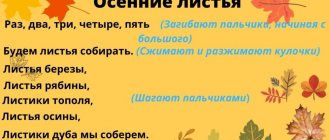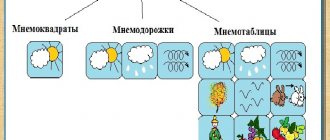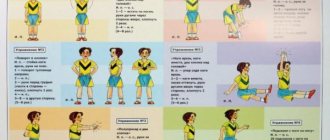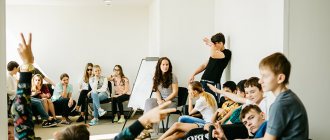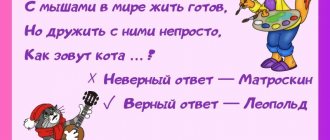Card index of finger games on lexical topics for preschoolers
New YearNew Year's toys
The holiday is approaching, the Christmas tree is being decorated.
(Raise their hands up “to the top of the tree” and, lowering them down, spread them to the sides.)
We hung up toys: beads, balls, crackers.
(Alternately connect the thumb with the rest
.)
And here the lanterns hang, delighting the children with their sparkle.
(They twirl their palms in the air - “flashlights.”)
New Year's holiday We have been waiting for the holiday for a long time. Let's rub palms together. Winter has finally come. Clench your fists and press them together. Finally winter has come. Fingers “walk” along the table, along the knees. I brought a Christmas tree for a visit. Fingers show the Christmas tree, index fingers interlock. We all approached the Christmas tree, round dances started. Circular movements with the hands. Spin around, dance, lower your hands, relax. Even a little tired. Santa Claus come quickly, press your palms together, then stretch them forward. Bring us gifts.
Gifts Santa Claus brought gifts: “Walking” with their fingers on the table. Primers, albums, stamps, For each name they fold down dolls of bears and cars, one finger at a time, first on the Parrot and the penguin, on the right hand, then on the left hand. Half a bag of chocolate Made from the fingers of the right hand And a fluffy puppy! puppy's face, bent Woof! Woof! middle and index fingers - “ears”.
On the Christmas tree We had fun on the Christmas tree, Rhythmic clapping of our hands And we danced and frolicked. Fist bumps. Afterwards, the good Santa Claus “walks” with his middle and index fingers on the table. He gave us gifts. “draw” a large circle with their hands. He gave us huge bags, containing delicious items: Rhythmic clapping of hands, Candies in blue papers, Bend your fingers, starting with the big one, Nuts next to them, a pear, an apple, one golden tangerine.
Christmas tree They are waiting for the prickly beauty and “draw” a Christmas tree with their hands. In every home in December. Make a “house” with your palms. Lanterns will be lit on the branches, “lanterns” will be shown. Sparks fly in the silver. Hands above head, fingers extended. The house will immediately become festive. They join hands and dance in a circle. A round dance will begin. Santa Claus is in a hurry with gifts, They walk in a circle with an imaginary New Year is coming. a bag over your shoulders. Decorating the Christmas tree One, two, three, four, five Alternately connect the fingertips of both hands, starting with the thumb. We will decorate the Christmas tree. They join their palms in a “house” above their heads and spread their arms to the sides. We hang balls. They connect the fingertips of both hands, forming balls. Bright lanterns. Press their palms together, fingers spread, perform rotational movements with their palms forward and back. Cheerful Parsley, Show a long nose and various toys: They stretch their palms forward and a little naughty bear they show “bear’s paws” and sway from side to side and a little bunny they put their open palms to their heads
New Year New Year is coming! (Clap our hands) Children dance in a circle. (The hands are clasped with the fingers, the arms are extended, the hands are rotated in and out) Balls are hanging on the Christmas tree, (Alternately we connect the fingers on both hands, forming a ball) The lanterns are glowing. (Lanterns) Here are the ice flakes sparkling, (Clench and sharply unclench your fists alternately) Snowflakes are spinning. (Move your hands easily and smoothly) Santa Claus is coming to visit, (Fingers walk on his knees or on the floor) He brings gifts to everyone. (Rub your palms together) To count the gifts, (Clap your knees or the floor, one hand with your palm, the other with your fist, then change) We will bend our fingers: (massage each finger in turn) 1,2,3,4, 5,6,7,8,9,10.
"Herringbone"
There is a Christmas tree in front of us: (interlace the fingers of both hands)
Cones, needles, (clench fists, point out index fingers)
Balls, lanterns, (round fingers, connect fingertips)
Bunnies and candles, (clench your fingers into a fist, pointing your index and middle fingers up)
Stars, people. (put palms together, spread fingers).
"Father Frost"
This finger is Santa Claus. (hands clench into fists, thumbs up)
He has a red nose (the index fingers are bent out of the fists one by one)
There is a gray beard. (bend middle fingers)
We always look forward to seeing him! (make beckoning movements with palms)
He will come with the Snow Maiden (“fingers walk” on the table)
And he will bring gifts. (clap hands)
Why do you need finger gymnastics?
What to do if you can’t concentrate on an important task? It seems like nothing complicated, but you’ve been sitting in front of the computer for 1.5 hours, and “things are still there.” It's simple - spend a couple of minutes doing finger exercises. Nikolay Yagodkin, founder of the Advance educational technology center, told the online magazine EVA.RU about this.
Simple exercises will help revive the brain in emergency mode. They not only synchronize both hemispheres, but develop coordination of movements, fine motor skills and attention. Just 5 minutes of fun exercises for 40 minutes will increase your intellectual tone no worse than an energy drink. The only difference is that you will not get harmful consequences.
This effectiveness is biologically determined. Most of the brain controls fine motor skills. Complex tasks in this area “load” the brain no worse than any other intellectual activity. In this case, there is no outflow of blood from the brain to the muscles, as during physical exercise. By focusing on the process, the depth of breathing and blood flow to the brain increases.
Finger exercises are not just a boost of energy and concentration, but also an excellent way to relax. Rest, as you know, is a change of activity, which from the point of view of the brain means a change in the zone of activity. 2 minutes of exercise is better than 10 minutes of just rest as you switch to another activity. There is no guarantee that your brain is actually resting while lying on the couch.
Finger exercises also stimulate the creation of new neural connections. Our brain is a cunning and complex system that tries to save resources and maintain the usual course of things. If you write/eat/wipe dust with your right hand all your life, then you have strengthened the corresponding neural connection. Try to do all this with your left hand and you'll really puzzle your brain, because it doesn't usually deal with this. The usual task has changed, which means that in order to adapt, you will have to build a new neural connection.
This is also a great way to physically warm up your hands. Most people work at a computer or constantly write at a desk. Sitting in one position for 8 hours or more, we get problems with posture and vision. If we write or type a lot (usually also in one position), then we risk developing carpal tunnel syndrome. This is a neurological disease that causes long-term pain and numbness in the fingers due to compression of the median nerve.
However, doing finger gymnastics is not easy. In order to masterfully control the movements of the hands, you need to develop a skill. In this case, the same algorithms work as in any training. Each person has their own pace, but if you practice every day, you will master even the most difficult exercises. Juggling works even better - but this is the next stage.
To see how this is implemented, watch our series of videos:
Despite all the difficulties, it is worth it. Finger gymnastics is suitable for all ages. Children develop fine motor skills, adults can tune in to a serious task, and for pensioners this is an excellent way to prevent age-related changes such as Alzheimer's disease.
MAGAZINE Preschooler.RF
THE PHENOMENON OF FOLK FINGER GYMNASTICSAt the present stage, there is a revival of national culture, the issue of using folk experience in educating the younger generation is being increasingly explored. In different peoples of the world, in the practice of raising children, there are national finger games, accompanied by funny poetic forms. In preschool and secondary educational institutions, during classes and lessons, teachers introduce finger exercises from different peoples of the world into their work, which are of great value in the development of children.
Finger games and gymnastics have great educational potential, being an excellent universal, didactic and developmental material. This is an exciting, fun and rewarding activity. The famous teacher V. A. Sukhomlinsky said: “The mind of a child is at the tips of his fingers”
[14]
,
“The origins of the abilities and talents of children are at the tips of their fingers” [13]
.
Even in ancient times, it was believed that “the hand is the instrument of all instruments.”
, wrote in particular Aristotle.
Later, in the works of I. Kant it was pointed out that “the hand is a kind of external brain, it is the human brain that has come out”
, and J-J.
Rousseau, in his novel about education “Emile,”
wrote about the needs of a small child:
“... he wants to touch everything, take everything in his hands. Do not disturb him, this is an absolutely necessary matter for him. This is how he learns to distinguish between heat and cold, hardness and softness, heaviness, size and shape of objects. The child learns about the properties of the things around him by comparing what he sees with the sensations he receives from his hands" [14]
.
Modern researchers also speak out in favor of these games, in particular E. F. Cherenkova notes that games with fingers develop the child’s brain, stimulate the development of speech, creativity, and imagination.
Studying the historiography of this issue, E. F. Cherenkova discovered that finger games have been widespread among various peoples of the world for a long time. In China, exercises with stone and metal balls are common. Regular exercises with them improve memory, the functioning of the cardiovascular and digestive systems, eliminate emotional stress, develop coordination of movements, strength and dexterity of the hands, and maintain vitality. And in Japan, exercises for palms and fingers with walnuts are widely used. Our children were taught to play “Ladushki”
,
"Magpie-white-sided"
.
Today, experts are reviving old games and inventing new ones. Publishers publish many manuals containing finger games that require nothing more than desire to play. In popular, specialized, scientific journals, articles talking about their benefits are increasingly appearing, the games themselves are published so simple and unpretentious, but, as we know, everything ingenious is simple.
In the literature you can find many approaches to classifying these games. For example, E. Leonova and E. Tetenkina divide finger gymnastics into:
- self-massage of hands and fingers;
- exercises at the table;
- finger games;
- exercises to activate the eye muscles.
L. Grineva suggests using the following games, accompanied by poetry:
- games with counting sticks, developing attention and imagination, introducing geometric shapes and the concept of symmetry;
- laying out letters from various materials (mosaic, seeds, nuts, buttons, twigs, etc.)
; - games with plasticine;
- paper games,
- games with hex pencils, cereals, beads, nuts.
S. Prishchepa, V. Popkova, T. Konyakhina use the following types of games when working with children:
- manipulative games (
“Ladushki-ladushki” ,
“Soroka-white-sided”
); - plot finger exercises (
“A flower is blooming” ); - finger exercises in combination with sound gymnastics (with pronunciation of sounds)
; - finger kinesiological exercises or “brain gymnastics”
, developed by G. and I. Dennison.
With their help, the work of the left hemisphere is compensated; their implementation requires attentiveness and concentration from the child (
“Ear-nose” ,
“Ring”
); - finger exercises combined with self-massage of the hands and fingers (
“Washing hands under running hot water” ); - theater in hand (
“Fairy Tale” - children act out a fairy tale character).
You can use them multiple times throughout the day:
- in the morning with a small subgroup of children or individually;
- during morning exercises;
- at physical education sessions;
- during physical education classes (at the beginning of a set of general developmental exercises; in the final part - self-massage of the hand and with the help of massage balls)
; - before lunch, when children are waiting for an invitation to the table;
- on a walk in the warm season;
- at the beginning of outdoor games or during the game;
- at leisure, holidays, entertainment.
Finger games carried out daily lead to the best possible results and by the end of preschool age the child’s hands become more mobile and flexible, which contributes to the successful mastery of writing skills in the future, the development of all mental processes, including attention and communication abilities (in games in pairs “boy” and a girl"
).
Finger gymnastics allows you to activate the left hemisphere of the brain (logical, “rational”
, which processes information entering the brain sequentially, analytically), which is characterized by an analytical approach to solving problems based on the principle of induction
(from particular to general)
in left-handers, because
They have a predominant right hemisphere (non-verbal, figurative)
, which, unlike the left hemisphere, is characterized by a synthetic approach based on the principle of deduction.
Therefore, at 5-6 years of age, it is necessary to carry out diagnostics to determine the asymmetry profile in order to ensure the child’s successful brain function and consistency in the work of both hemispheres through finger games, emphasizes G. Logacheva [6]
.
M. S. Ruzina, who was involved in the selection and development of finger games, notes a number of their advantages, allowing:
- make a breakthrough in speech development - improve pronunciation and enrich vocabulary;
- prepare your hand for writing, which is especially important for children who will soon go to school;
- develop attention, patience, internal brake - the ability to restrain yourself exactly when it is necessary;
- stimulate imagination and manifestations of creative abilities;
- while playing, master the beginnings of geometry (origami)
; - learn to control your body, feel confident in the system of “bodily coordinates”
, which prevents the possibility of neuroses; - to feel the joy of mutual understanding without words, to understand the possibilities of non-verbal communication.
Finger exercises for the feet also contribute to the development of attention. “Fine motor skills of the toes influence the development of the corresponding parts of the brain”
[1]
.
These exercises bring the effect of novelty, and everything new attracts children; they are especially useful for hyperactive children (drawing with feet)
.
I. Malyukova recommends using finger games as an element of playful self-massage, since massage is a powerful biological stimulant that affects the functions of the skin, the level of supply of oxygen and nutrients to the body, the removal of decay products, the contractility and performance of the muscles of the massaged hand, as well as on the plasticity of joints and ligaments.
Self-massage of the hands is also a means of increasing immunity, since nerve endings are located on the palms. If their activity is activated, the functional state of internal organs improves [7]
.
E. N. Ryzhakova, V. A. Rakitina recommend using finger exercises in children’s learning the alphabet, as they help consolidate visual-spatial images of letters and develop mental functions necessary for studying the school curriculum:
- attention, memory, thinking;
— visual-spatial perception and representation;
- fine motor skills;
— speeches;
— constructive praxis.
Exercises encourage children to be creative, activate the brain, and increase muscle tone. Finger alphabet is one of the means of preventing dyslexia and dysgraphia [13]
.
To unleash a child's creative potential, finger games can be used in combination with musical and theatrical activities in the classroom. [2]
. And G. Sokolova notes the advisability of using this kind of games with children during origami classes
[9]
.
Finger play trainings arouse interest and a strong emotional mood in children, which they first use independently and then include in finger activities. Their content may reflect lexical topics for study in speech therapy groups, finger play training on paper, where children draw with fingers, bones, pebbles, ropes [4]
.
I. Galyant and M. Galyant believe that with children it is necessary to use exercises with which hands depict specific objects, this in turn contributes to the development of thinking and attention [3]
Here are examples of folk finger games: Russian folk finger games “Kissel”
,
“Masha the Mistress”
, Vepp folk
“Rings”
, Belarusian
“Goat”
.
Kissel
Grandma cooked jelly
On a pea, (The right hand “stirs the jelly.” The fingertips of the right and left hands are connected, the hands diverge at an angle)
For Andryushechka. (The palm of the right hand rests on the chest)
The falcon flew and flew (Palms crossed, thumbs hooked together)
Through grandma's threshold. (Crossed palms flap like wings)
Here he beats his wings,
Grandma's jelly spilled.
So there is no jelly
In the skull (Hands hit the sides hard several times, then stretch forward and down, fingers spread.
Hands spread to the sides.
The hands show the turtle pot again)
In a skull (Rounded palms, when lowered, form a skull pot)
At the old lady's
On the hill. (Hands down the hill again)
Grandma cries: “Ay-ay-ay1” (Hands are “wiped”)
Don't cry, grandma, don't cry! (The index finger of the right hand threatens)
So that you become cheerful
We'll make some jelly. Wow, so much! (The right hand stirs the jelly again
Hands spread wide to the sides)
Masha the hostess
Our Masha
She was smart
Everyone has a job in the hut
Today I asked: (Clap your hands. Either the right or left hand is on top)
Little doggy
He washes with his tongue (The thumb of the right hand is protruded - “ear”, the index finger is bent, the rest are straightened. The “dog” bends towards the “bowl” - the rounded left palm, “washes it” (movements of the little finger to the side and back)
.
The mouse picks up
Crumbs under the table. (The bent little finger and index finger of the right hand are the “ears”; the closed and bent middle, ring and thumb fingers are the “muzzle.” The “mouse” pinches the straightened left palm)
Cat under the window (The fingers of the right hand are collected, as in the “mouse” figure, but the fingers representing the muzzle are not bent, but rounded)
He scrapes with his claws, (The fingers of his right hand scrape the palm of his left)
Chicken in earrings
Swept out the hut
Sweeps the hut.
I shook my little foot.
Lay down the little one
Under the threshold on the side. (The right palm “sweeps” the straightened left one. Vigorous shaking of the fingers of the right hand. The relaxed right hand rests on the table or on the knees. The left hand covers it from above.)
Before the game, you need to explain to the child that golichok is a forgotten name for a broom, and to tremble means to shake out, shake.
When the game is repeated, the hands change roles.
Rings
Children 6-7 years old, having gathered in a circle and choosing a driver, collect rings at his expense. Suddenly the driver commands: “No middle!” - and the players continue to bust, skipping the middle finger. Then follows the command: “Without the little finger!” etc. The pace of the count speeds up, the one who made a mistake leaves the game.
Option three. Entertainment for teenagers: the most difficult version of the game is reverse rings. However, with good training, it is also accessible to older preschoolers. The left hand clasps the index and thumb, the right hand clasps the thumb and little finger.
In time with the counting, the left and right hands make simultaneous multidirectional movements: the left hand closes the thumb alternately with the middle, ring and little fingers, and the right hand, respectively, with the ring, middle and index. Then move in the opposite direction.
Goat
The goat came out
From the new entryway. (The left hand represents a goat: the middle and ring fingers are bent, the thumb presses them from below, the little finger and index finger are straightened. This position is maintained throughout the game.)
He bent his neck:
“Give me some bread quickly!” (The right hand is clenched into a fist, bent at the wrist.)
Expose the "horns"
“Give me the pie! (Your right hand is clenched into a fist, your middle finger is straight.)
He extended his hoof:
“Give me some water to drink!” (The right hand is folded into a boat)
While playing to the beat of the words, both hands move back and forth, “butting” the air. When repeating the game, the hands change roles.
The feasibility of using finger gymnastics with preschool children was shown by the results of an experiment conducted in one of the preschool educational institutions in the city of Novocheboksarsk, Chuvash Republic. First, the children were diagnosed for the level of development of the ability to distribute attention, then a system of work was built and a plan was outlined. For two months, finger games, exercises, and physical education sessions were regularly conducted with the children in an entertaining way. Then the children were diagnosed again and during the analysis of the data obtained, the hypothesis was confirmed that the process of developing attention through finger gymnastics is an effective method of developing attention while observing the consistency of its implementation in classes and in free time.
Thus, based on the experience of peoples, outstanding teachers, thinkers, philosophers, we can conclude that finger games and exercises have enormous potential for the development of various abilities (mathematical, creative, musical, etc.) in preschool children.
. Such games do not require a lot of time or material costs, they can be played anywhere and anytime.
Literature
- Aleksandrovskaya M. Finger exercises for legs // Engagement-1998. - No. 5. -P.32.
- Bodrachenko I. Child, music, theater // Hoop. – 2006. – No. 3 – P. 18-20.
- Galyant I., Galyant M. Finger games // Preschool education. – 2003. – No. 1. – P. 50-53.
- Eroshina S.T. Finger play training // Speech therapist. – 2007. – No. 4 – P.81.
- Leonova E., Tetenkina E. Let's help ourselves! // Preschool education. - 2004. - No. 3.
- Logacheva G. Lefty // Preschool education. - 2007. - No. 8. - P.72.
- Malyukova I. Playful self-massage as a means of preparing the hand for writing // Preschool education. – 2008. – No. 2. – pp. 79-82.
- Sidorenko L. My fingers will tell // Preschool education. – 2008. – No. 7. – P. 67-70.
- Sokolova G. For girls and boys, finger gymnastics: finger play using origami elements // Preschool education. – 2005. – No. 6. – pp. 34-36.
- Plutaeva E., Losev P. Development of fine motor skills in children five to seven years old // Preschool education. - 2005. - No. 8. — P.28.
- Prishchepa S., Popkova P., Konyakhina T. Fine motor skills in the psychophysical development of preschoolers // Preschool education. - 2005.- No. 1 .- P.60.
- Ruzina M.S., Afonkin S.Yu. Country of finger games. - SPb.: CRYSTAL-2002.
- Ryzhakova E.N., Rakitina V.A. We develop our fingers and make letters. // Speech therapist. – 2007. – No. 2. – P.68-74.
- Cherenkova E.F. Original finger games. - M.: DOM 21vek, 2007.
| Next > |
